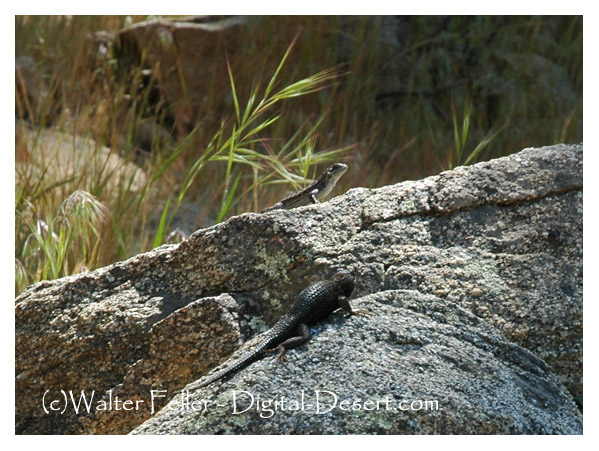Western Fence Lizard
Sceloporus occidentalisFamily: Phrynosomatidae Order: Squamata Class: Reptilia

DISTRIBUTION, ABUNDANCE, AND SEASONALITY
The western fence lizard is probably California's most common reptile. This adaptable lizard is found throughout California except in true desert, where it is restricted to riparian and high mountain locations. Elevation sea level to 3250 m (10,000 ft).
SPECIFIC HABITAT REQUIREMENTS
Feeding:
Western fence lizards have been shown by Johnson (1965), Rose (1976a), and others, to feed almost exclusively on terrestrial invertebrates, especially insects. Spiders, ticks, scorpions, centipedes, and isopods are taken less frequently. Cannibalism has also been reported.
Cover:
Basking or perching sites (usually tree trunks, woodpiles, wooden fences, rock piles, or walls of buildings) with some vertical element appear to be an important habitat factor. When pursued, individuals seek cover by running to the opposite side of their perch (Nussbaum et al. 1983), or take refuge in crevices or burrows, or under surface objects such as rocks or boards. Tree bark (Gray and Stroud 1980), rocks, and boards, as well as crevices and burrows, serve as hibernation sites during cold periods.
Reproduction:
Males require elevated perch sites to observe mates or rival males or to display. Eggs are usually laid in damp, friable, well-aerated soil, in pits dug by the female.
Water:
No information on water requirements. Does not require permanent water.
Pattern:
Widely distributed and common in most California habitats except densely forested and desert types.
SPECIES LIFE HISTORY
Activity Patterns:
Activity is almost exclusively diurnal. Nussbaum et al. (1983) noted some nocturnal activity during warm periods. The length of warm season activity varies geographically, but in most localities fall and winter inactivity occurs. Juveniles appear active later in the fall than adults.
Seasonal Movements/Migration:
Significant seasonal movements or migration have not been reported. Lizards may occasionally move outside the normal area to find suitable nest sites or hibernation sites. Aggregations of hibernating fence lizards have been reported (Gray and Stroud 1980).
Home Range:
Home range sizes vary geographically and in response to resource abundance. Tanner and Hopkin (1972) calculated home ranges for fence lizards in an open shrub habitat in Nevada as 0.2-0.7 ha (0.6-1.7 ac) for males, and 0.04-0.2 ha (0.1-0.5 ac) for females. At Mt. Diablo in central California, Ruth (1977) calculated fence lizard densities at 22-33/ha (8.9-13.4/ac).
Territory:
During spring, males defend a loosely defined territory of up to 7.5 m (25 ft) radius. The territory is defended less vigorously as summer progresses. Territorial defense is accomplished by posturing and physical combat.
Reproduction:
Courtship in captive individuals has been observed as early as March and April (Fitch 1940), and copulations have been witnessed in May and June (Davis 1980). The interval between copulation and egg-laying is probably from two weeks to a month. Eggs are deposited mid-May to mid-July (Stebbins 1954) and the incubation period (Davis 1980) is about 60 days.
Niche:
The western fence lizard is the commonest lizard in most habitats in which it occurs. Some competition for food may occur with sympatric S. graciosus. Considerable dietary overlap has been observed where the two species coexist (Rose 1976b). Differential microhabitat utilization resulting in minimal spatial overlap apparently allows the two species to co-occur. Western fence lizards are important prey items for a variety of vertebrate species including snakes (Fitch 1940) and predatory birds. Nussbaum et al. (1983) report that shrews occasionally feed or dormant fence lizards. They are seldom found in open fields or extremely barren areas (Stebbins 1954).
Source:
CDFW California Wildlife Habitat Relationships. Accessed [N/A]
https://wildlife.ca.gov/Data/CWHR
